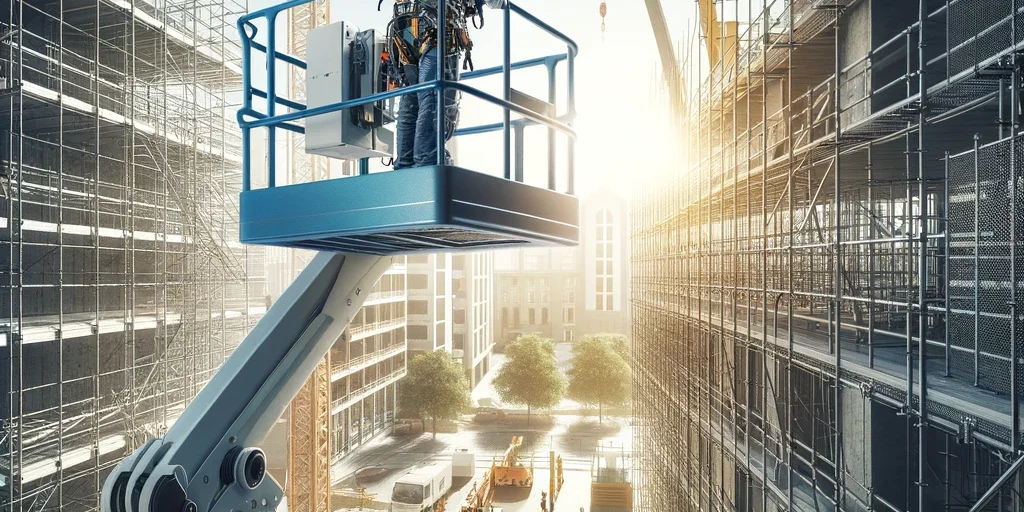Working at height includes all tasks performed over 2 meters above ground level, where significant risks are involved. An aerial work platform is a machine specifically designed to allow operators to carry out temporary jobs at elevations up to and beyond 100 meters. These machines enable quick positioning at the required height, depending on the type of aerial work platform in use. Controls can be operated directly from the platform or remotely from the ground.
Aerial work platforms are used in both indoor and outdoor environments. Given their versatility, many models are available to suit different site conditions and height requirements. As a result, more companies now choose to rent aerial work platforms for working at height, making them one of the most in-demand machines on the market.
Aerial Work Platforms: What Is Landing at Height?
In the context of aerial work platforms, “landing at height” refers to the process of positioning an operator at an elevated level using an elevating work platform (EWP). These machines, commonly known as aerial lifts or baskets, include two main types:
Aerial work platforms based on load center stability
The first group includes platforms where the load’s center of gravity always remains within the tipping lines.
The second group consists of those where the center of gravity may extend beyond the tipping lines.
A frequent question regarding aerial work platforms is whether operators can step out of the basket at height. Since these platforms are designed to serve as a work location—not for access—exiting the basket is generally not permitted. However, exceptions may be made if a risk assessment shows that alternative solutions would pose a greater hazard than exiting the aerial work platform.
Safety When Using Aerial Work Platforms at Height
Accidents during aerial work platform operations often stem from inattention or failure to follow proper procedures.
Common safety breaches include:
-
Not using appropriate personal protective equipment (PPE).
-
Operating outside the manufacturer’s specified load center.
-
Exiting the platform to access high areas.
These mistakes can cause serious incidents that affect the safety of operators.
In Italy, the most common types of aerial platform-related accidents include:
-
Falls due to improper use of guardrails.
-
Falling objects from height.
-
Crush injuries from collisions with scaffolding or buildings.
-
Using unauthorized equipment in elevated areas.
Employers must implement all necessary safety measures. According to Article 111 of the Consolidated Law on Health and Safety at Work, employers must select the safest equipment for the job based on two key principles:
-
Give priority to collective protection measures over individual ones.
-
Choose equipment according to the specific nature of the work.
Types of Aerial Work Platforms
Aerial work platforms offer versatile lifting solutions for construction companies, painters, electricians, landscapers, and more. Several main types are available:
Self-propelled aerial platforms
These are used in warehouses or hard-to-reach areas. They move vertically and can reach up to 10 meters.
Electric vertical platforms
Compact and ideal for indoor use, these platforms are easy to transport and can reach up to 14 meters.
Scissor lift platforms
Equipped with a wide basket and powerful lifting system, these can extend to 18 meters.
Spider lifts
These feature flexible arms for exceptional maneuverability, perfect for roof work and navigating obstacles both on the ground and at height.
Telescopic boom lifts
Ideal for getting close to the working area, these platforms are perfect for construction sites and for repair work.
Conclusion
Aerial work platforms are essential machines for safe, efficient, and fast operations at height. Mostly professionals such as builders, painters, electricians, and landscapers use them.
Many models are available for rental at rentmas, including self-propelled, vertical, scissor, spider, and telescopic platforms. Choosing the right aerial platform depends on the nature of the job and the required height.
Following proper safety procedures is crucial to avoid accidents. Skipping PPE, misusing the center of gravity, or accessing elevated areas beyond design limits can result in serious risks for operators.
If you want to find out when it is necessary to use an aerial work platform, look at our previous article.






